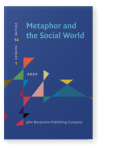Vol. 12:1 (2022) ► pp.69–91
Socio-pragmatic potential of (verbo)-visual metaphtonymy in Internet memes featuring Donald Trump
The present study explores (verbo)-visual metaphtonymy in Twitter-based Internet memes featuring Donald Trump, focusing both on the patterns of conceptual interaction of metaphor and metonymy and their socio-pragmatic potential to influence Internet users. The results of the study reveal four types of (verbo)-visual metaphtonymy employed in the analyzed Internet memes. The types are differentiated in accordance with the complexity of the metaphoric source: metaphtonymy with a simple metaphoric source, metaphtonymy with a metaphoric source structured by simple metonymy, metaphtonymy with a metaphoric source structured by metonymic chain, and metaphtonymy with a metaphoric source structured by radial metonymy. In all the four types, the metaphoric target is structured by metonymic amalgam – a metonymic complex in which metonymies that are based on different ICMs merge due to the association of contiguity that is relevant in the current communicative and social/political context. Besides metonymic amalgam, the study introduces the notion of radial metonymy – a metonymic complex that emerges when one metonymic source gives access to several metonymic targets. We argue that the analyzed metaphtonymies rest on conceptual incongruity created to trigger negative evaluative inferences and emotional responses to shape Trump’s image.
Article outline
- 1.Introduction
- 2.Theoretical background
- 2.1The notion of a (political) Internet meme
- 2.2Metaphor and metonymy in multimodal contexts
- 3.Data and methods
- 4.Results and discussion: Trump’s metaphtonymic images
- 4.1Metaphtonymy with a simple metaphoric source
- 4.2Metaphtonymy with a metaphoric source structured by simple metonymy
- 4.3Metaphtonymy with a metaphoric source structured by metonymic chain
- 4.4Metaphtonymy with a metaphoric source structured by radial metonymy
- 4.5Percentages of the four types of metaphtonymy observed in the corpus
- 5.Conclusions
- Note
-
References
